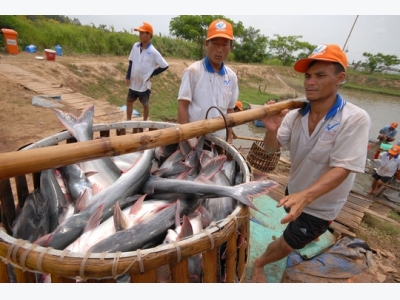Vietnam mulls ways of dealing with strict US anti-dumping duties

The US has more than 10 times imposed anti-dumping duties on Vietnam’s catfish exports. If it continues installing new barriers, Vietnam may need to find new markets for the exports, experts say.
According to the Vietnam Association of Seafood Exporters and Producers (VASEP), the catfish export turnover to the US in August 2017 was $18.44 million, a sharp fall of 58.5 percent compared with July and 55 percent compared with the same period last year.
The decline has been anticipated. In mid-September, the US DOC announced the preliminary decision on imposing anti-dumping duties on frozen fillet catfish after the POR 13, from August 1, 2015 to July 31, 2016.
Meanwhile, since August 1, 2017, 100 percent of Vietnam’s catfish export consignments have been examined for labeling, information on packages and chemical residue. The US Farm Bill provisions which were applied sooner than expected have had big impact on Vietnam’s exports.
At a conference about catfish industry held in Can Tho City recently, Vo Hung Dung, director of VCCI (Vietnam Chamber of Commerce and Industry) Can Tho, said that Vietnam’s catfish exports to China unexpectedly increased by 46 percent in the first half of the year, while exports to the US decreased by 5.7 percent.
Since August 1, 2017, 100 percent of Vietnam’s catfish export consignments have been examined for labeling, information on packages and chemical residue.
Just within the last two years, China has become a big consumer of Vietnam’s catfish, with consumption up from 10 percent to 20.5 percent of Vietnam’s exports. The US now consumes 21-22 percent.
In principle, if Vietnam can satisfy provisions stipulated in the Farm Bill, the catfish exports to the US would still be stable. However, as Dung warned, “This is a task which is as difficult as going to heaven.”
Duong Nghia Quoc from VINAPA (Vietnam Pangasius Association) has confirmed that the Farm Bill and anti-dumping duties will be the biggest obstacles for Vietnam’s catfish to enter the US market.
Both VINAPA and VASEP predicted that catfish exports to the US would be decreasing towards the end of the year.
Nguyen Huu Nguyen, chair of Chau Phu Seafood Cooperative in An Giang province, said that the US has many times set barriers against Vietnam’s catfish, and that if the US continues installing such barriers, Vietnam needs to look for new markets, because Vietnam’s catfish products have high quality and satisfy requirements on food hygiene.
“No need to be too pessimistic about the US market,” he said, adding that the farming needs to be programmed so that the oversupply won’t happen. “The output will determine the catfish price.”
Le Chi Binh, deputy chair of the An Giang province Aquaculture and Seafood Processing Association, also thinks that Vietnamese enterprises should not concentrate on the US market.
In the first eight months of the year, Vietnam exported $416 million worth of shrimp, 4.4 percent lower than the same period last year.
Có thể bạn quan tâm
 US’s monitoring programme worries Vietnamese seafood firms
US’s monitoring programme worries Vietnamese seafood firms Many seafood businesses of Vietnam have expressed their worries when there are only more than two months left before SIMP takes effect.
 South Korea likes Vietnamese squid and octopus
South Korea likes Vietnamese squid and octopus South Korea continues to be the Number 1 importer of squid and octopus from Vietnam, accounting for 34 per cent of total exports
 US warns VN seafood exporters of unregulated fishing
US warns VN seafood exporters of unregulated fishing The US National Oceanic and Atmospheric Administration (NOAA) has warned Vietnamese seafood processors, importers and exporters to fight against illegal